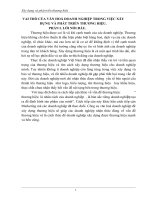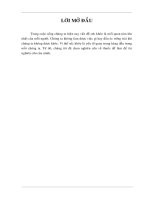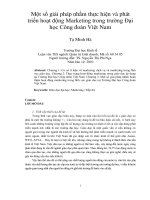- Trang chủ >>
- Sư phạm >>
- Sư phạm mầm non
Economic appraisal of kinnow production and its marketing in Sirsa dustrict of Haryana, India - Trường Đại học Công nghiệp Thực phẩm Tp. Hồ Chí Minh
Bạn đang xem bản rút gọn của tài liệu. Xem và tải ngay bản đầy đủ của tài liệu tại đây (225.23 KB, 7 trang )
<span class='text_page_counter'>(1)</span><div class='page_container' data-page=1>
<i><b>Int.J.Curr.Microbiol.App.Sci </b></i><b>(2017)</b><i><b> 6</b></i><b>(11): 4045-4053 </b>
4045
<b>Original Research Article </b>
<b>Economic Appraisal of Kinnow Production and its Marketing in </b>
<b>Sirsa District of Haryana, India </b>
<b>Nirmal Kumar1, Anju Duhan2*, Jitender Bhatia3 and Vinod Malik4</b>
1
District Extension Specialist (Agricultural Economics), KVK, Sirsa, India
2
HSB, GJUS & T Hisar, Haryana, India
3
Department of Agricultural Economics, India
4
District Extension Specialist (Plant Pathology), KVK, Sirsa, India
<i>*Corresponding author </i>
<i><b> </b></i> <i><b> </b></i><b>A B S T R A C T </b>
<i><b> </b></i>
<b>Introduction </b>
Horticultural sector play a vital role in
providing the livelihood security to the
farmers under the changing agriculture
scenario. The diversification in agriculture for
improving sustainability, profitability and
productivity will help in not only improving
the farm income but also will generate gainful
employment. India is the world’s second
largest producer of fruits (57.73 million tons)
with its projected value touching 98 MT by
the year 2020-2021 (Banerjee, 2009), whereas
for vegetables, India's diverse climate ensures
availability of all varieties of fresh fruits and
vegetables. It ranks second in fruits and
vegetables production in the world, after
China. As per National Horticulture Database
published by National Horticulture Board,
during 2014-15 India produced 86.602
million metric tons of fruits and 169.48
million metric tons of vegetables. The area
<i>International Journal of Current Microbiology and Applied Sciences </i>
<i><b>ISSN: 2319-7706 Volume 6 Number 11 (2017) pp. 4045-4053 </b></i>
Journal homepage:
An economic analysis of kinnow has been presented through studying their costs and
returns. The average first year establishment costs per hectare for kinnow has been worked
out to be Rs. 399466. The overall per hectare per year returns from kinnow orchards have
been worked out to be Rs. 125478. The overall economic viability of the kinnow fruit,
mainly net present value, internal rate of return, benefit-cost ratio and payback period have
been computed as Rs. 261258, 15.57 per cent, 2.19 and 7.6 years, respectively. The
average per quintal marketing cost at producers’ level has been found to vary to the extent
of Rs. 1120, Rs. 1120, Rs.1195.83 and Rs. 1215.61 for channels -I, II, III and IV,
respectively. The average per quintal marketing cost borne by the commission /wholesaler
in channel -I was Rs. 660.58, whereas as it was Rs. 620.92, Rs. 532.48 and Rs. 252.39 in
channels II, III and IV, respectively at the retailer’s level and in channel-IV, whole of the
marketing cost was borne by the producer as there was direct marketing of produce. A
comparison of price spread through different marketing channels has revealed that
producers’ share in consumers’ rupee was the highest (about 82.21%) in channel-IV, due
to self-sale in the local market. The marketing efficiency has been found to be highest in
channel-IV. The producer got maximum benefits in channel-IV, therefore this channel
should be followed to make producer highest beneficiary; although this channel has its
own limitations.
<b>K e y w o r d s </b>
Kinnow production,
Marketing, Margin,
Cost, Channel and
Economic analysis of
kinnow.
<i><b>Accepted: </b></i>
28 September 2017
<i><b>Available Online:</b></i>
10 November 2017
</div>
<span class='text_page_counter'>(2)</span><div class='page_container' data-page=2>
<i><b>Int.J.Curr.Microbiol.App.Sci </b></i><b>(2017)</b><i><b> 6</b></i><b>(11): 4045-4053 </b>
4046
under cultivation of fruits stood at 6.11
million hectares while vegetables were
cultivated at 9.54 million hectares. The vast
production base offers India tremendous
opportunities for export. During 2015-16,
India exported fruits and vegetables worth Rs.
8,391.41 crores which comprised of fruits
worth Rs. 3,524.50 crores and vegetables
worth Rs. 4,866.91 crores (Anonymous,
16). In Haryana, during the year
2015-16 Sirsa district ranked at the top with 9.65
thousand hectares (49.15%) of area and
191.78 thousand tones (63.55%) of
production of total citrus cultivation in the
state. In Sirsa, mostly Kinnow (<i>Citrus nobilis </i>
X <i>Citrus deliciosa</i>) species of mandarin
(Santra) and malta species of sweet orange are
being grown among citrus fruits. Therefore,
there is a need to boost its production as well
as expand its area, which is possible only
when a detailed cost and marketing analysis is
carried out systematically.
Therefore, this study was undertaken with the
following objective; (1) to study the cost and
net returns from kinnow production, (ii) to
find out its economic viability and (iii) to
study marketing channel, marketing cost,
price spread and marketing efficiency of
Kinnow production in the Sirsa district of
Haryana.
<b>Materials and Methods </b>
The present study was conducted in Sirsa
district of Haryana state taking into account
share of production and acreage of kinnow.
Two blocks out of the district and three
villages from each block were selected for the
extraction of information from 60 farmers for
the year 2015-16.
The growers were divided into three groups
viz. small (0.01 – 2.00 ha), medium
(2.01-4.00 ha) and large (above 4.01 ha). The data
were collected on payments paid by growers
for purchase of various inputs, resources
employed, establishment of orchard and
cultivation of crop and income received as
well as costs involved in marketing of kinnow
produce.
The economic viability of an enterprise like
kinnow orchard was estimated by employing
statistical tools like net present value (NPV),
pay-back period, internal rate of return (IRR)
and benefit cost ratio (BCR).
The information on marketing aspects of
kinnow produce was analysed by computing
marketing cost, margins, price spread and the
marketing efficiency. The modified formulae
were used for separating the ‘post-harvest
losses during marketing at different stages of
marketing as well as for estimating the
producers’ share, marketing margins and
marketing losses.
<b>Growers’ net price </b>
The net price received by the grower was
estimated as expressed in Equation (1):
NPF = {GPF} – {CF} – {LF × GPF} …(1)
Where, NPF is the net price received by the
farmers (Rs./kg), GPF is the gross price
received by the farmers or wholesale price to
farmers (Rs./kg), CF is the cost incurred by
the farmers during marketing (Rs/kg), and LF
is the physical loss in produce from harvest
till it reaches assembly market (per kg).
<b>Marketing margins </b>
</div>
<span class='text_page_counter'>(3)</span><div class='page_container' data-page=3>
<i><b>Int.J.Curr.Microbiol.App.Sci </b></i><b>(2017)</b><i><b> 6</b></i><b>(11): 4045-4053 </b>
4047
Intermediary margin = Gross price (sale
price) – Price paid (cost price) – Cost of
marketing – Loss in value during handling (2)
Thus, the total marketing margin of the
market intermediary (MM) was calculated as
per equation (3):
MM = MMW + MMR ...(3)
Similarly, the total marketing cost (MC)
incurred by the producer/ seller and by
various intermediaries was calculated by
equation (4):
MC = CF + CW + CR …(4)
Total loss in the value of produce due to
injury/ damage caused during handling of
produce from the point of harvest till it
reached the consumers was estimated as per
Equation (5):
ML = {LF × GPF} + {LW ×GPW} + {LR ×
GPR} (5)
<b>Marketing efficiency </b>
Modified marketing efficiency (ME) formula
as defined by Acharya and Agarwal (2001) is
given below:
NPF
ME = --- (6)
MM + MC + ML
Where, NPF is net price received by the
farmers (Rs. / kg), MM is the marketing
margin, MC is the marketing cost, and ML is
the marketing loss.
<b>Results and Discussion </b>
<b>Cost analysis</b>
The establishment cost included expenditure
on preparation of land, digging, filling and
planting, planting material, purchase of
essential input, etc. The operational cost
included human labour cost, investment on
nutrients (manures + fertilizers), expenditure
on plant protection chemicals, irrigation
charges, training/ pruning charges, permanent
fencing, pond cost and land rent etc.
Maintenance cost of orchards was obtained by
using the quantity of inputs used per plant.
The returns from kinnow orchard start from
fifth year and it will be continued beyond 28
years, unlike Nagpur (oranges) manadarins.
The total first year establishment costs on
kinnow plantation (Table 1), revealed that
costs of digging and filling and planting
material was Rs. 5500 and Rs. 6764/h
respectively in over all category.
The expenditure on construction of pond,
installation of drip irrigation, payment for
land leased in and permanent fencing of field
was (71.35%, 11.80 %, 7.75% and 2.33%/ha)
respectively. This indicates that the first year
establishment cost increased with increase in
the size of holding possibly due to more
application of fertilizers and plant protection
chemicals. These results are in conformity
with the findings of Gangwar <i>et al.,</i> (2005)
and Bhat <i>et al.,</i> (2011).
The year wise establishment incurred upto
first four years in kinnow establishment
(Table 2) revealed that establishment cost was
maximum for all the size groups during the
first year and in the successive years (upto
plant started bearing); it was 40-50 per cent of
the first year cost. The cost in the second year
and onwards was low as expenditure incurred
only on purchase of some inputs and
maintenance of orchard.
</div>
<span class='text_page_counter'>(4)</span><div class='page_container' data-page=4>
<i><b>Int.J.Curr.Microbiol.App.Sci </b></i><b>(2017)</b><i><b> 6</b></i><b>(11): 4045-4053 </b>
4048
The item-wise operational cost of kinnow
cultivation on per hectare basis (Table 3)
indicated that overall expenditure incurred on
nutrients was Rs. 15248 (38.55%), indicating
that it increased with increase in size of land
holding. Whereas, inter-cultural operation and
hoeing (Rs.7779), insecticides and fungicides
(Rs.6359), showed decreasing trend with
increasing size of farms.
The other costs involved in maintenance of
kinnow orchard were pruning and cutting
(10.81%) and watch and ward (5.80%). The
total operational costs increased with the
increase in the size of land holding.
<b>Gross returns and net profits </b>
The per hectare returns from kinnow orchards
(Table 4) were highest in large size of
holdings (Rs.132605), followed by medium
(Rs.128389), small (Rs. 117862) orchards
with an overall return Rs.125478. The similar
pattern also existed in case net returns of
kinnow cultivation.
The per hectare returns from kinnow orchard
(Table 4) were highest in large size of holding
(Rs.132605), followed by medium
(Rs.128389), small (Rs. 117862) with an
overall returns of (Rs.125478). The similar
pattern also existed in case net returns of
kinnow cultivation. It indicated that larger the
size of an orchard, higher would b ethe
returns which implies economics of scale of
production. The similar findings had also
reported by Thakur <i>et al.,</i> (1986) and Sudha
and Reddy (1988).
<b>Economics of kinnow production </b>
Table 5 reveals benefit-cost ratio (B-C ratio),
net present value (NPV), pay-back period and
internal rate of return (IRR) of orchards. In
this study the NPV and B-C ratio have been
calculated at 12 per cent discount rates.
</div>
<span class='text_page_counter'>(5)</span><div class='page_container' data-page=5>
<i><b>Int.J.Curr.Microbiol.App.Sci </b></i><b>(2017)</b><i><b> 6</b></i><b>(11): 4045-4053 </b>
4049
<b>Table.1 </b>Operation- wise first year establishment cost of kinnow on different size groups of
kinnow orchards
(Rs./ha)
<b>Particulars </b> <b>Small </b> <b>Medium </b> <b>Large </b> <b>Overall </b>
Preparation of land and layout 3260
(0.82)
3321
(0.83)
3367
(0.84)
3310
(0.83)
Digging and filling of pits 5500
(1.38)
5500
(1.37)
5500
(1.37)
5500
(1.38)
Cost of filling 3145
(0.79)
3156
(0.79)
3165
(0.79)
3154
(0.79)
Cost of planting material 6875
(1.73)
6760
(1.67)
6610
(1.65)
6764
(1.69)
Planting cost 1375
(0.35)
1380
(0.34)
1382
(0.34)
1379
(0.35)
Training/pruning 2750
(0.69)
2780
(0.69)
2798
(0.70)
2773
(0.69)
Cost of drip establishment 46250
(11.64)
47500
(11.86)
48000
(11.97)
47154
(11.80)
Permanent fencing 9250
(2.33)
9280
(2.35)
9364
(2.33)
9291
(2.33)
Cost of tool & implements 2810
(0.71)
2895
(0.72)
2987
(0.74)
2887
(0.72)
Cost of pond construction 285000
(71.70)
285000
(71.18)
285000
(71.06)
285000
(71.35)
Rental value of land 30000
(7.55)
31525
(7.87)
31665
(7.89)
30978
(7.75)
Miscellaneous 1250
(0.31)
1310
(0.33)
1270
(0.32)
1276
(0.32)
<b>Total </b> <b>397465 </b>
<b>(100) </b>
<b>400407 </b>
<b>(100) </b>
<b>401108 </b>
<b>(100) </b>
<b>399466 </b>
<b>(100) </b>
<b>Table.2 </b>Year wise establishment cost of Kinnow orchards on different size groups of land holding
(Rs./ha)
<b>Year </b> <b>Small </b> <b>Medium </b> <b>Large </b> <b>Overall </b>
I 112465
(45.08)
115407
(45.01)
116108
(44.93)
114466
(45.01)
II 41568
(16.66)
42829
(16.70)
43224
(16.73)
42451
(16.69)
III 44009
(17.65)
45516
(17.75)
45890
(17.76)
45038
(17.72)
IV 51427
(20.61)
52669
(20.54)
53184
(20.58)
52330
(20.58)
Total 249469
(100.00)
256421
(100.00)
258406
(100.00)
254285
(100.00)
</div>
<span class='text_page_counter'>(6)</span><div class='page_container' data-page=6>
<i><b>Int.J.Curr.Microbiol.App.Sci </b></i><b>(2017)</b><i><b> 6</b></i><b>(11): 4045-4053 </b>
4050
<b>Table.3 </b>Operational cost of kinnow orchard on different size group of land holding
(Rs./ha)
<b>Sr. No. </b> <b>Particulars </b> <b>Small </b> <b>Medium </b> <b>Large </b> <b>Overall </b>
1 Manures and fertilizers 14520
(38.11)
14960
(38.40)
16672
(39.31)
15248
(38.55)
2 Intercultural operation and hoeing 7665
(20.12)
7765
(19.93)
7963
(18.78)
7779
(19.67)
3 Irrigation and drip maintenance 2456
(6.45)
2545
(6.53)
2786
(6.57)
2575
(6.51)
4 Pruning and cutting 4125
(10.83)
4256
(10.94)
4524
(10.67)
4277
(10.81)
5 Insecticides and fungicides 6254
(16.40)
6242
(16.02)
6663
(15.71)
6359
(16.08)
6 Replacement cost 925
(2.43)
956
(2.45)
1237
(2.92)
1019
(2.58)
7 Watch and ward 2156
(5.66)
2234
(5.73)
2563
(6.04)
2292
(5.80)
<b>Total </b> <b>38101 </b>
<b>(100.00) </b>
<b>38958 </b>
<b>(100.00) </b>
<b>42408 </b>
<b>(100.00) </b>
<b>39549 </b>
<b>(100.00) </b>
<b>Table.4 </b>Cost and returns of kinnow orchard on different size group of land holding
(Rs./ha)
<b>Sr. No. </b> <b>Particulars </b> <b>Small </b> <b>Medium Large Overall </b>
1 Land rent 32689 32710 32913 32756
2 Amortized fixed cost 50677 51052 51141 50932
3 Operational cost 38101 38958 42408 39549
4 Expected depreciation on fixed investment @ 4% 4499 4616 4644 4578
5 Interest on operational cost @ 12% per annum 4572 4675 5089 4746
6 Total cost (1 to 5) 130538 132011 136195 132562
7 Production (qt) 207 217 224 215
8 Gross returns 248400 260400 268800 258040
9 Net returns from kinnow 117862 128389 132605 125478
<b>Table.5 </b>Economic viability of kinnow orchard on different size groups of land holding
Measures of investment worth Size of orchards (n=60)
Size of land holding 0.01 to 2.00 ha 2.01 to 4.00 ha Above 4.00 ha Overall
Payback period (years) 7.5 7.8 7.2 7.6
Net present value Rs.)
At discount rate of 12% 238399 266341 267107 261258
Internal rate of return (%) 14.57 15.56 16.61 15.57
Benefit-cost ratio
</div>
<span class='text_page_counter'>(7)</span><div class='page_container' data-page=7>
<i><b>Int.J.Curr.Microbiol.App.Sci </b></i><b>(2017)</b><i><b> 6</b></i><b>(11): 4045-4053 </b>
4051
<b>Table.6 </b>Channel-wise marketing cost and price spread in disposal of Kinnow produce
(Rs./q)
<b>Sr. No. </b> <b>Functionary </b> <b>Channel-I </b> <b>Channel-II </b> <b>Channel-III </b> <b>Channel-IV </b>
1 Net Price received by producer/purchase Price of pre harvest
contractor
1120(51.28) 1120(58.95) 1195.83(63.85) 1215.61(82.21)
2 Cost incurred by the pre-harvest contractor 258.02(11.81) 258.02(13.58) 270.17(14.42) 252.39(17.19)
3 Net margins of pre-harvest contractor 172.98(7.92) 106.98(5.63) -- -
4 Sale price of pre-harvest contractor/purchase price of
wholesaler
1551(71.02) 1485(78.16) 1466(78.27) -
5 Cost incurred by the wholesaler 273.31(12.51)
6 Net margin of wholesaler 96.69(4.43) - - -
7 Sale price of wholesaler/purchase price of retailer 1921(87.96) - - -
8 Cost incurred by the retailer 129.25(5.92) 262.90(13.84) 262.31(14.00) -
9 Net margin of retailer 133.75(6.12) 152.10(8.01) 144.69(7.73) -
10 Sale price of retailer/purchase price of consumer 2184(100.00) 1900(100.00) 1873(100.00) 1468(100.00)
Note: Figures in parentheses are the percentage to the consumer’s price
<b>Table.7 </b>Marketing efficiency of different channels involved in disposal of produce
<b>Particulars </b> <b>Channel-I Channel-II Channel-III Channel-IV </b>
Net price received by producer(Rs./q) 1120 1120 1195.83 1215.61
Marketing margin (Rs./q) 403.42 259.08 144.69 0.00
Marketing cost (Rs./q) 660.58 520.92 532.48 252.39
Marketing efficiency 1.05 1.44 1.77 4.82
The NPV varied from small (Rs. 238399) to
large orchards (Rs.267107), depending upon
the size of orchards which indicated that NPV
was highest in large orchard and lowest in
small orchard.
The IRR ranging from 14.57 per cent in small
orchards to 16.61 per cent in large orchards
indicating that kinnow cultivation was a
profitable enterprise. The average rate of
return per year for the whole period of the
orchard will be 14.57 per cent for small, 15.56
per cent for medium and 16.61 per cent for
large orchards. The B: C ratio calculated for
small, medium, large and overall orchards
was 2.11, 2.24, 2.14 and 2.19 respectively,
indicating that the medium orchardist much
better than others as returns per rupee
invested was highest. The pay-back period of
kinnow orchard was in the range of 7.2 years
to 7.8 years. These findings are in close
conformity with the results of Gangwar and
Singh (1998).
<b>Marketing channels </b>
The following four major marketing channels
were identified in the study area in disposal of
kinnow depicted as under.
</div>
<!--links-->
Giải pháp marketing nhằm phát triển du lịch TP Hồ Chí Minh đến năm 2015
- 5
- 604
- 8








